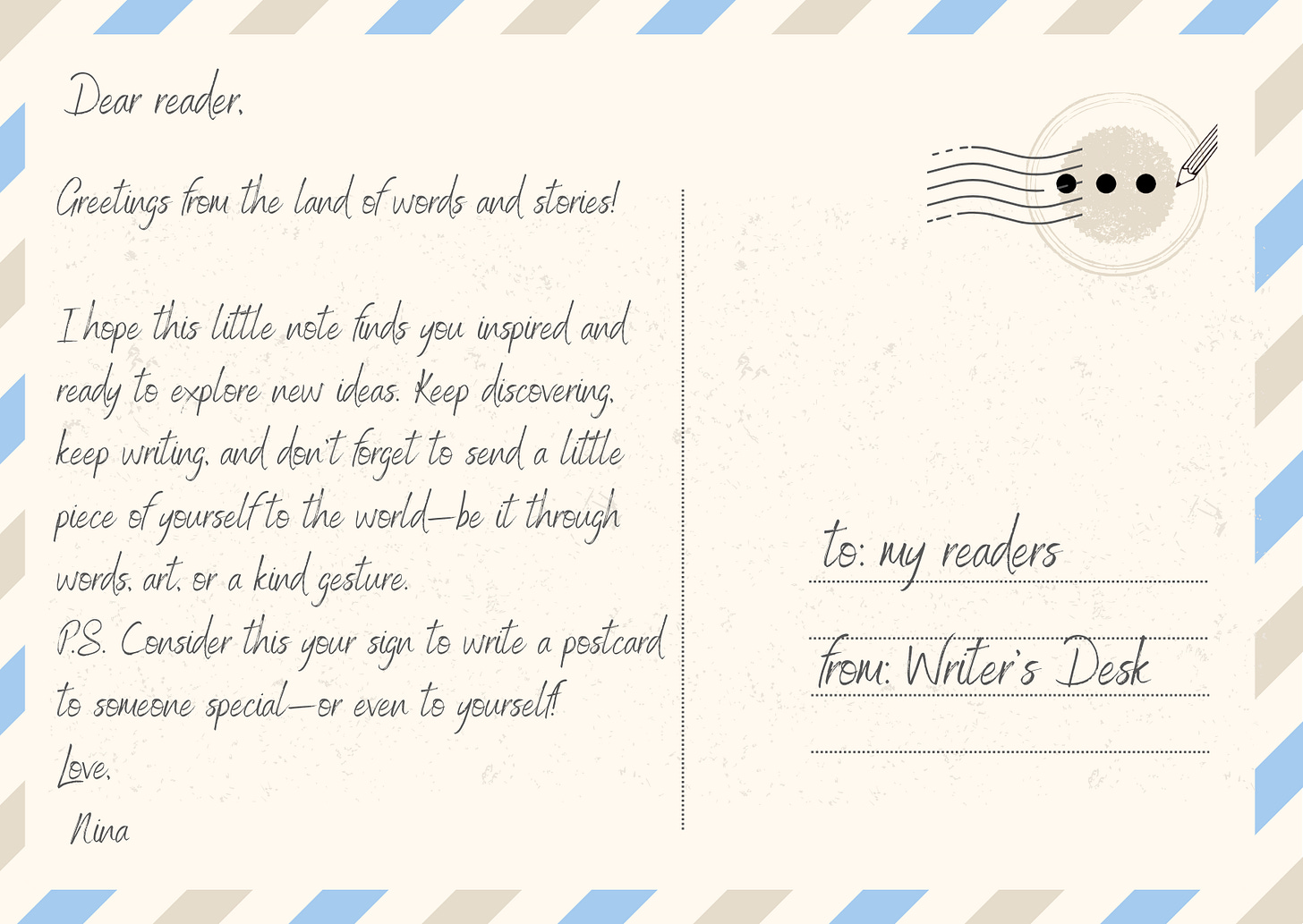How and Why the Ritual of Sending Postcards Brings Joy and How to Properly Perform It
Plus a bonus writing lesson
Qué lindos son estos, said the lady in the small, cluttered post office in Playa del Carmen. She was referring to the postcards I was sending to my friends scattered around the world. It was the last day of my one-month trip.
This moment felt like a ritual—almost like a small ceremony to mark the end of my travels. Choosing which postcard goes to which friend, finding a nice, quiet place to write them, picking the right words, carefully placing the stamps, locating the post office, and finally sending them off into the world.
Simple and beautiful, postcards have a unique way of making people happy. I’d even say they bring joy to both the sender and the recipient. So, what’s behind this joy?
Well, they usually feature a beautiful picture or drawing—whether of a scenic place, an eye-catching object, or a captured moment—a snapshot of a nicer reality. And then there’s the text: short, sweet, and usually casual. It’s something that brings a smile, a lighthearted reminder of a happy moment. And then, the stamp, a miniature work of art—a tiny time capsule in its own right.
Postcards also represent a fading tradition, a form of communication that’s nearly extinct in the age of instant digital messages. And maybe that’s what makes them so romantic. They connect us with our friends but also with the “before times”—holding a piece of paper, writing by hand, searching for a mailbox, and feeling the thrill of placing the card into its travel machine.
Until they reach their destination, postcards are often forgotten. But once they arrive, they again bring such innocent joy. At that moment, the recipients are transported back to the sender’s past. It’s almost as if time and space are weirdly intertwining.
I’m not sure which one of my friends started this tradition, but I do remember my first postcard. It was on my first trip abroad—to Dublin. I remember walking into the beautiful and grandiose General Post Office and feeling like I was about to perform some ancient ritual.
From that first trip, I continued the tradition on every journey. I usually buy four postcards—one for each of my closest friends. And it’s not just random shopping. I carefully pick the ones that match each friend’s personality. I never buy them at the first shop—it’s always a process. Then I carry them in my bag for days.
Usually, on the last day of the trip, I search for a peaceful place to write them—a quiet bench in the park or a cozy café. Finding stamps becomes a mini-adventure of its own. Finally, I drop them in a mailbox or post office, as if to officially say, “My journey here is complete, but yours is just beginning.”
It’s one of those small rituals that strengthen our friendships. A small gesture, but one that carries a lot of weight. I’m certain it somehow deepens our bond. We even have a dedicated group chat for addresses, and every time someone moves, they update us with the new one.
So, it’s not just a funny little random ritual. It’s a planned and meticulous ceremony—a long-cherished tradition. And everyone is invited to be a part of it. Because it will bring you joy.
Oh, and the postcards I sent from Mexico? Unfortunately, they never arrived. And they were so beautiful…
How to write a postcard
Writing a postcard is deceptively challenging, even for a writer. Summarizing your thoughts in just a sentence or two is almost as tricky as writing the perfect headline (at least for me). You have limited space, so every word matters. It’s an excellent exercise in saying something meaningful with simplicity and impact. I often find myself scribbling across the lines or running out of space entirely, trying to fit in everything I want to say.
Also, keep in mind that a postcard isn’t entirely private. You’re writing for both the recipient and the curious postal workers who might glance at it along the way. This forces you to be intentional—not just about what you say, but how you say it. It's a unique balance of creativity, thoughtfulness, and restraint, all within the confines of a small rectangle.
Here are a few of my tips on how to write a really good postcard:
Start with a simple greeting. A “Dear” attached to the recipient’s name works pretty well—it’s friendly and personal.
Share a snippet of your story. Mention something about your day, trip, or a random thought that popped into your head. Keep it short and sweet—space is very limited!
Be mindful of your audience. Postcards aren’t private, so choose words that are light, fun, and thoughtful.
Wrap it up with affection. End with “Love,” “Best,” or whatever feels natural—it adds a personal touch.
Sign your name and send some love.
Or, forget the rules entirely and just scribble whatever you want. It’s your postcard, after all! Intention is what matters most.
Love,
Nina





This is a tradition that should be maintained as it gives a fascinating view of the places visited for people in the future who come across the postcard.
This substack (https://espc.substack.com/ ) publishes postcards from a collection that come all over the world that were sent in the 20th century (and IIRC a few from the 19th). It's fascinating and hopefully your postcards will allow the same thing to happen in another 50-100 years
I know a friend who sends them to herself from other countries and she hangs them in her entry hallway. Your point of sending to a friend is also wonderful.